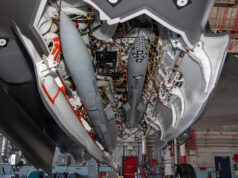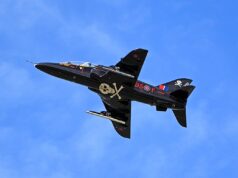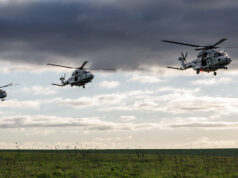A British RC-135 ‘Rivet Joint’, a dedicated electronic surveillance aircraft, has again been deployed to conduct surveillance of Russian forces in occupied Ukraine.
The UK has been conducting these flights to gather intelligence about Russian forces in the area.
A 🇬🇧 British RC-135 'Rivet Joint', a dedicated electronic surveillance aircraft, was once again deployed to gather intelligence on the size and location of 🇷🇺 Russian forces in occupied 🇺🇦 #Ukraine. pic.twitter.com/8VrSWCUZ1G
— George Allison (@geoallison) December 28, 2022
The RC-135W Rivet Joint and its sensors are designed to undertake ‘signals intelligence’ missions. In other words, they ‘soak up’ electronic emissions from communications, radars and other systems.
As we need to post this each time, here’s the usual disclaimer. This isn’t a new occurrence. It is pretty routine. The UK has long been gathering intelligence about Russian forces since long before the invasion of Ukraine, and it should be noted that these flights are designed to be visible so that the public and Russia know they’re happening. If it were a secret, I would not know. Also, for those remarking, ‘this isn’t new’, that’s right, but people only know this often happens because it is reported often.
British surveillance aircraft being over the area isn’t unusual, but we are seeing a significant increase in the frequency of the flights over the last few months for obvious reasons.
What does the RC-135W do?
According to the Royal Air Force website, the RC-135W Rivet Joint is a dedicated electronic surveillance aircraft that can be employed in all theatres on strategic and tactical missions. Its sensors ‘soak up’ electronic emissions from communications, radar and other systems.
“RC-135W Rivet Joint employs multidiscipline Weapons System Officer (WSO) and Weapons System Operator (WSOp) specialists whose mission is to survey elements of the electromagnetic spectrum in order to derive intelligence for commanders.”
The Royal Air Force say that Rivet Joint has been deployed extensively for Operation Shader and on other operational taskings. It had been formally named Airseeker, but is almost universally known in service as the RC-135W Rivet Joint.
The UK operates three of these aircraft.













Thanks to George and the team for 2022 and look forward to more this year and of course the comments by the readers
Indeed, thanks George & the team for all your hard work.
Excellent RAF UK contribution to Armed Forces of Ukraine situational awareness.
#StandWithUkraine
#SlavaUkraine
Please allow me to add to the thanks. We may sometimes get carried away with our opinions but imagine not having the freedom to write about our troubled world. So many can’t speak nor write for fear of reprisals, long live ukdj.
Well over 5000 flying hours to its credit and will continue to fly until at least 2035.
LINK
Is it fair to say that this and other assistance (provided by the UK and the rest of free world) prior to and during the conflict may well have helped the Ukrainians turn the tide on what could heve been a completely different outcome? .
Indeed it is because an Artillery battle requires situational awareness and forward observation to plan and target fire. You can only deliver the potential of HIMARS when you know where the build up of enemy forces and material are. So EW and ISTAR are essential. Being able to estimate the value of targets and make best use of limited ammunition is far better than the Soviet doctrine of blast it all to bits because we can. No need for logistics stress and presenting a target to the enemy, nor war crime of indiscriminate civilian and military targets.
UAV for getting in close for targetting and even dropped munitions has been effective, but without the battlefield wide situational awareness you could waste a lot of opportunities…
If u like artillery supply, perun just put one of his epic hour long videos on YouTube about artillery shortages in Ukraine. His weekly uploads are a delight to watch/listen to. I learned a lot this week.
https://youtu.be/deK98IeTjfY
Thanks for your suggestion. Fact based analysis is always welcome, historic perspective a bonus.
Happy New Year 2023..
I like him, watched his vid on 6th Gen fighters last night
He does a great job of gathering the research and presenting it well. Perun normally does one long video a week. I sometimes listen while going to sleep. Sometimes takes few nights to get through the video.
I also like to watch Denys Davydov daily video on Ukraine as he also gathers lots of info and presents it well.
https://youtu.be/iW72aIbSe10
Thanks, this wasn’t on my Radar.
…thanks.
I also like REPORTING FROM UKRAINE.
https://www.youtube.com/@RFU
He is very detailed and plausible from a military tactics/news perspective that is not really covered elsewhere I think.
And that is 100% the truth.
Plonking one munition on a pile of fuel or other munitions is a massive force multiplier. That is the best use of HIMARS. It saves civilian lives used that way.
The Russians can’t do they waste 1000’s of shots stressing their logistics to commit war crimes.
Regards Ammo,Interesting tweet:
https://i.postimg.cc/X7K0ZBJ7/Opera-Snapshot-2023-01-01-211256-twitter-com.png
what isn’t widely known is that the UK sorted out a deal with Pakistan to supply Ammo (which I presume we are purchasing) which the RAFs C17s are transporting to the Ukraine (via Cyprus and Romania) from Pakistan
Ionpfrb,
Read a very interesting article the other day which shone a light on the arty war inside the Ukraine. Well worth a butchers:
Great aircraft. I do wonder if there is much demand for 24 hour coverage of this kind of intel hoovering?
Maybe it’s replacement will be unmanned long endurance aircraft that can communicate all the data to a base. It would still need all the kit on board and the crews would have to be able to operate their their work station like they were onboard.
“Maybe it’s replacement will be unmanned long endurance aircraft that can communicate all the data to a base.”
Check out callsign ‘Forte 11’ on FlightRadar24. That’s a USAF Global Hawk, out of Sigonella. Quite often appears to be spending 8 hours or more on station, going back and forth, from 55,000ft.
Don’t forget Forte 10 and 12 also. 🙂
How did I forget Forte 10 and 12? Hope I haven’t hurt their feelings!
Happy New Year to everyone from across the pond!
Although in Grinch mode, may I wish you all the best and thank you for Heads Ups appreciation of issues.
Peaceful New Year.
Yes happy new year George!
Happy new year everyone from NZ!
These are great assets and I hope that they deliver some lessons we don’t forget about procurement.
Unlike attempts to turn Nimrod into an AEW aircraft (£2.75 billion in 2022 prices) and then attempts to turn 50 year old Nimrod’s into new MPA’s (£4.8 billion in 2022 prices), we bought an existing asset with proven technology which was built in larger numbers than we required thus pushing down the unit costs.
We need to stop treating niche defence requirements as job creation scheme’s, buy proven technology and concentrate our defence R&D and manufacturing investment on core capabilities that we do well.
https://www.telegraph.co.uk/world-news/2023/01/02/ukraine-russia-war-updates-live-ukraine-russia-war-drones-strike/
Stay safe guys. Thank you for the service you give and risks you take alongside our other services
The UK is one of only a few nations that can field this type of aircraft. The Rivet Joint replaced Nimrods recently.
I found it on Flight Radar 24 over the Black Sea south of Crimea, with a “little friend” behind it… a Eurofighter Typhoon. Heading back to Waddington now.